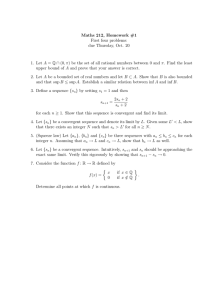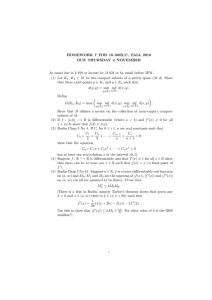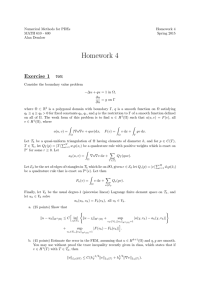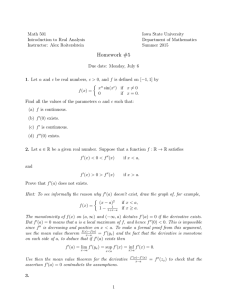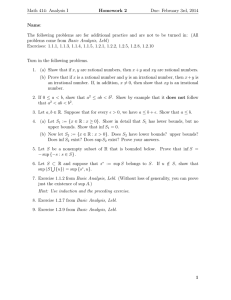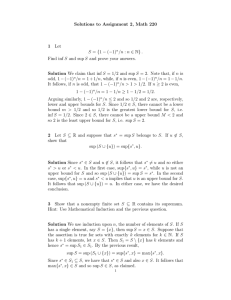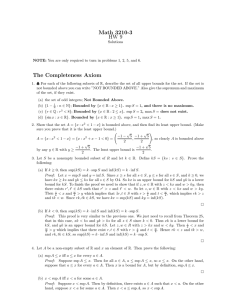Course 2 - Homework Assignment 2 Solution φ w > λ
advertisement
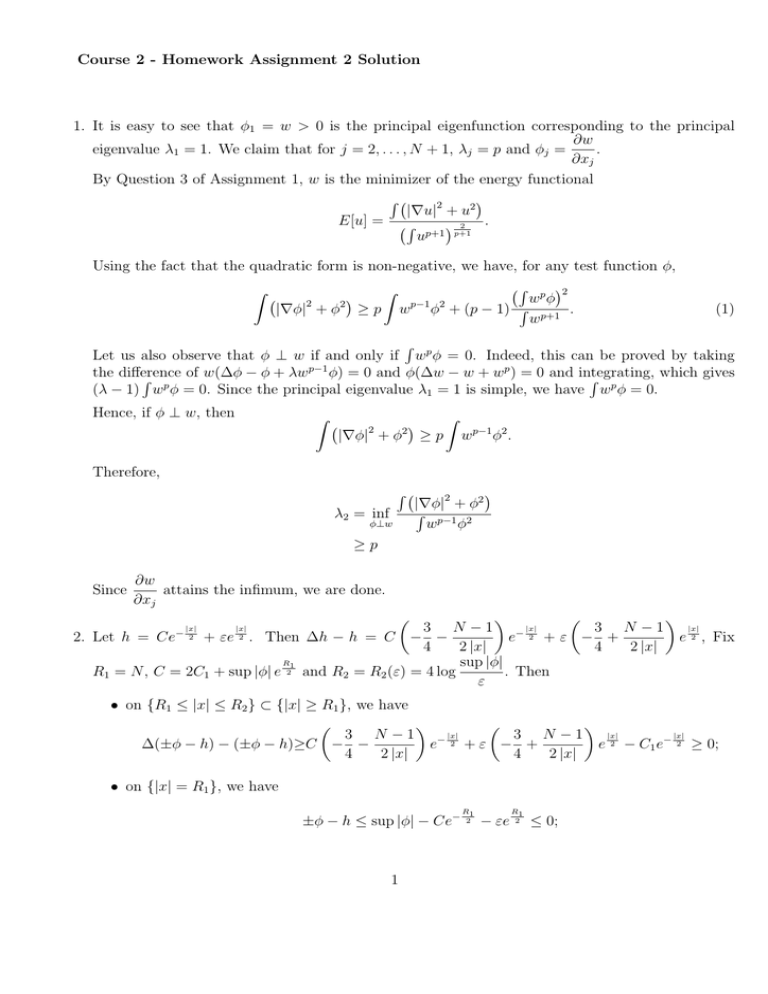
Course 2 - Homework Assignment 2 Solution
1. It is easy to see that φ1 = w > 0 is the principal eigenfunction corresponding to the principal
∂w
eigenvalue λ1 = 1. We claim that for j = 2, . . . , N + 1, λj = p and φj =
.
∂xj
By Question 3 of Assignment 1, w is the minimizer of the energy functional
¢
R¡
|∇u|2 + u2
E[u] = ¡R
¢ 2 .
up+1 p+1
Using the fact that the quadratic form is non-negative, we have, for any test function φ,
¡R p ¢2
Z
Z
¡
¢
w φ
2
|∇φ| + φ2 ≥ p wp−1 φ2 + (p − 1) R p+1 .
w
(1)
R
Let us also observe that φ ⊥ w if and only if wp φ = 0. Indeed, this can be proved by taking
p−1
p
the difference
which gives
R p of w(∆φ − φ + λw φ) = 0 and φ(∆w − w + w ) = 0 and integrating,
R p
(λ − 1) w φ = 0. Since the principal eigenvalue λ1 = 1 is simple, we have w φ = 0.
Hence, if φ ⊥ w, then
Z
¡
2
|∇φ| + φ
2
¢
Z
≥p
wp−1 φ2 .
Therefore,
R¡
λ2 = inf
φ⊥w
|∇φ|2 + φ2
R
wp−1 φ2
¢
≥p
Since
∂w
attains the infimum, we are done.
∂xj
µ
¶
µ
¶
|x|
3 N − 1 − |x|
3 N −1
2. Let h = Ce
+ εe . Then ∆h − h = C − −
e 2 +ε − +
e 2 , Fix
4
2 |x|
4
2 |x|
R1
sup |φ|
R1 = N , C = 2C1 + sup |φ| e 2 and R2 = R2 (ε) = 4 log
. Then
ε
−
|x|
2
|x|
2
• on {R1 ≤ |x| ≤ R2 } ⊂ {|x| ≥ R1 }, we have
µ
µ
¶
¶
|x|
|x|
3 N − 1 − |x|
3 N −1
∆(±φ − h) − (±φ − h)≥C − −
e 2 +ε − +
e 2 − C1 e− 2 ≥ 0;
4
2 |x|
4
2 |x|
• on {|x| = R1 }, we have
±φ − h ≤ sup |φ| − Ce−
1
R1
2
− εe
R1
2
≤ 0;
• on {|x| = R2 }, we have
±φ − h ≤ sup |φ| − Ce−
R2
2
− εe
R2
2
≤ 0.
By comparison principle, there holds
±φ − h ≤ 0 on R1 ≤ |x| ≤ R2 ,
that is,
|φ| ≤Ce−
Letting ε → 0, we have |φ| ≤Ce
holds in the whole RN .
|x|
− 2
|x|
2
+ εe
|x|
2
on R1 ≤ |x| ≤ R2 .
on |x| ≥ R1 . Choosing a larger C if necessary, this estimate
3. (a) Let
R L¡
c=
inf
u∈H1 ((0,L))
E[u] =
|∇u|2 + u2
´ 2
³R
L p+1 p+1
u
0
¢
0
inf
u∈H1 ((0,L))
RL
and let {wk } be a minimizing sequence. By scaling invariance, we may assume that 0 wk3 = 1.
By Sobolev embedding, H1 ,→ L∞ is compact, so {wk } has a bounded convergent subseRL
quence. With an abuse of notation, let wk → w and then 0 w3 = 1. Using w ∈ H1 as a test
function and Fatou’s lemma, we have
Z L
Z L
¡
¢
¡
¢
2
2
c≤
|∇w| + w ≤ lim inf
|∇wk |2 + wk2 = c.
k→∞
0
0
Hence w is a minimizer. We need to show that w is a non-constant function for L > π (so
that w0 (x) < 0).
Suppose, on the contrary, that w ≡ 1. The relation E 00 [1 + tφ] ≥ 0 gives, for any test function
φ, as in (1) with w = 1 and p = 2,
Z
Z
Z L
1
0 2
2
φ)2 ≥ 0.
(φ ) − φ + (
L 0
³ πx ´
But the function φ(x) = cos
satisfies
L
Z
Z
Z L
1
0 2
2
(φ ) − φ + (
φ)2 < 0,
L 0
a contraction.
(b) See Lecture 3.
4. See lecture 3.
5. The Contraction Mapping Principle states that a contraction mapping T in a Banach space V has
a unique fixed point, that is there exists a unique solution x ∈ V such that x = T x. For example,
it can be used to solve nonlinear equations when the nonlinearity is small. We see its use in the
process of Liapunov-Schmidt reduction or the reduced problem of it.
2
6. The Fredholm Alternative states that if T is a compact linear mapping of a normed linear space L
into itself, then either x − T x = 0 has a nontrivial solution x ∈ L, or for each y ∈ L the equation
x − T x = y has a uniquely determined solution x ∈ L. In the second case, (I − T )−1 is bounded.
For instance, in the process of Liapunov-Schmidt reduction, this is useful when there is no explicit
formula for the linearized operator, that is, we can invert the operator once we know that the
homogeneous equation has no nontrivial solutions.
7. Let x = x0 + εy and U (y) = u(x). Then
U 00 − V (x0 + εy)U + Q(x0 + εy)U p = 0
U 00 − V (x0 )U + Q(x0 )U p = −(V (x0 + εy) − V (x0 ))U + (Q(x0 + εy) − Q(x0 ))U p .
As ε → 0, U 00 − V (x0 )U + Q(x0 )U p = 0 gives, by the hint,
µ
U (y) =
V (x0 )
Q(x0 )
1
¶ p−1
p
w( V (x0 )y),
where w00 − w + wp = 0. Note that U and U 0 decays exponentially to 0 at ∞. Multiplying both
sides by U 0 and integrating on (−∞, ∞), we see that the left hand side is 0 and the right hand
side becomes, after integrating by parts,
Z
Z
Q0 (x0 )
V 0 (x0 )
2
U +
U p+1
0=−
2
p+1
2 Z
µ
¶
µ
¶ p+1 Z
p
p
V 0 (x0 ) V (x0 ) p−1
Q0 (x0 ) V (x0 ) p−1
2
w ( V (x0 )y) dy +
wp+1 ( V (x0 )y) dy
=−
2
Q(x0 )
p + 1 Q(x0 )
p+1
2
µ
¶
µ
¶ p−1
Z
Z
0
1
Q
(x
)
V
(x
)
1
V 0 (x0 ) V (x0 ) p−1
0
0
2
p
p
w +
wp+1
=−
2
Q(x0 )
p + 1 Q(x0 )
V (x0 )
V (x0 )
R
00
p
0 2
2
p+1
Testing the equation
µ w − w + w = 0, we get
¶ ((w ) − w + w ) = 0. If we integrate the first
R
R
2
wp+1 = 0. Eliminating (w0 )2 , we have
integral, we have
(w0 )2 − w2 +
p+1
µ
¶Z
Z
Z
1
1
p+3
p+1
2
w =
+
w
=
wp+1 .
2 p+1
2(p + 1)
Therefore, the above equation is simplified to
0=−
V 0 (x0 ) 2Q0 (x0 ) V (x0 )
+
,
2
p + 3 Q(x0 )
or
(p + 3)Q(x0 )V 0 (x0 ) = 4Q0 (x0 )V (x0 ).
Note that it can also be written as
µ
V p+3
Q4
3
¶0
(x0 ) = 0.
8. Let r = r0 + εt and U (t) = u(r). Then
U 00 − V (r0 )U + U p = −(V (r0 + εt) − V (r0 ))U −
ε(N − 1) 0
U.
r0 + εt
As in the last question, when ε = 0,
p
1
U (t) = V (x0 ) p−1 w( V (x0 )y).
Testing the equation with U 0 , we have
εV 0 (r0 )
0=
2
Z
Z
1
(U 0 )2 .
r0 + εt
2
U − ε(N − 1)
Note that as ε → 0,
µ
1
1
=
r0 + εt
r0
εt
1−
r0
¶
+ O(ε2 )
so when we divide both sides by ε and take ε → 0, we get
Z
Z
εV 0 (r0 )
ε(N − 1)
2
0=
U −
(U 0 )2
2
r0
Z
Z
2
2
V 0 (r0 )
N −1
1
1
2
p−1
p−1
=
V (r0 ) p
w −
V (r0 ) V (r0 )
(w0 )2
2
r0
V (r0 )
V (x0 )
Using the equation for w, we have
Z
Z
0 2
− (w ) + w2 =
2
p+1
which gives
Z
w
p+1
2
=
p+1
Z
(p − 1)
Z
2
(w ) +
p+1
Z
0 2
w2
Z
2
w = (p + 3)
(w0 )2 .
Therefore, the necessary condition is
(p + 3)V 0 (r0 )
(p − 1)(N − 1)
=
V (r0 ),
2
r0
or
V 0 (r0 )
2(p − 1)(N − 1)
=
.
V (r0 )
(p + 3)r0
9. Referring to the paper, the Green’s function is constructed as follows. Let J1 (r) and J2 (r) be
respectively the solutions of the problem
J100 +
N −1 0
J1 − J1 = 0, J10 (0) = 0, J1 (0) = 1, J1 > 0
r
and
N −1 0
J2 − J2 + δ0 , J2 > 0, J2 (+∞) = 0.
r
They can be written in terms of modified Bessel’s functions, namely,
J200 +
J1 (r) = c1 r
2−N
2
Iν (r), J2 (r) = c2 r
4
2−N
2
Kν (r), ν =
N −2
,
2
where c1 , c2 are two positive constants and Iν , Kν are modified Bessel functions of order ν. They
are explicit when N = 3:
sinh r
e−r
J1 (r) =
, J2 (r) =
.
r
4πr
By computing the Wronskian of J1 , J2 ,
J10 (r0 )J2 (r0 ) − J1 (r0 )J20 (r0 ) =
for some constant c 6= 0. The Green’s function is then
½
J2 (r0 )J1 (r)
N −1
G(r; r0 ) = c0 r0
J1 (r0 )J2 (r)
1
c0 r0N −1
for r < r0 ,
for r > r0 ,
The Green’s function representation formula is
Z ∞
u(r) =
G(r; r0 )f (r0 ) dr0 .
0
5



